5 Chainsaw Maintenance Tips for Beginners
- February 14, 2024
- 0 comment
Chainsaws are indispensable tools for a wide range of woodcutting tasks, serving both professional and hobbyist needs with their robust cutting capabilities. To ensure these powerful tools continue to operate efficiently and safely, regular maintenance is a must. Proper care not only extends the life of a chainsaw but also enhances its performance and user safety. Here, we outline five essential maintenance tips that beginners can easily follow to keep their chainsaws in prime condition.
List of Chainsaw Maintenance Tips for Beginners:
- Bar Maintenance
- Sprocket and Mounting Hole Inspection
- Bar Edges Reconditioning
- Powerhead Cleaning
- Chain Tension and Sharpening
- Bonus Tip
Chainsaw Maintenance Tips for Beginners
1. Bar Maintenance
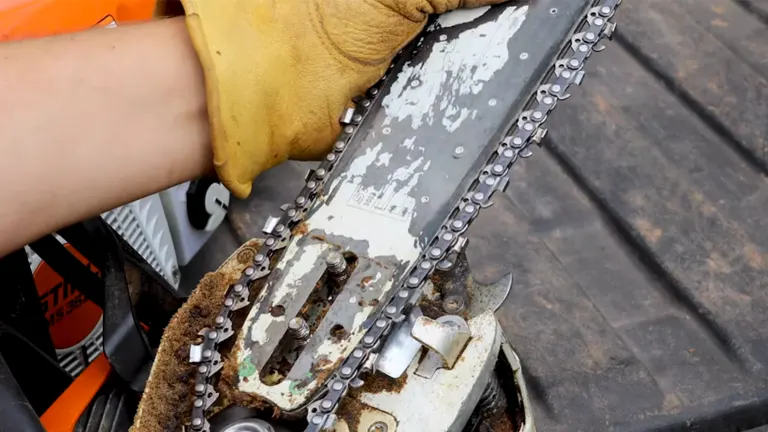
The chainsaw bar is crucial for guiding the chain and ensuring accurate cuts. To maintain the bar, start by removing it from the chainsaw with care, wearing protective gloves to avoid injuries from the sharp chain. Cleaning the bar is vital to remove sawdust, debris, and oil buildup that can affect performance. Use a specialized tool, often provided by chainsaw manufacturers like STIHL, to clean the bar’s groove and the oiler holes. Ensuring these parts are clean prevents chain jamming and ensures smooth operation.
2. Sprocket and Mounting Hole Inspection
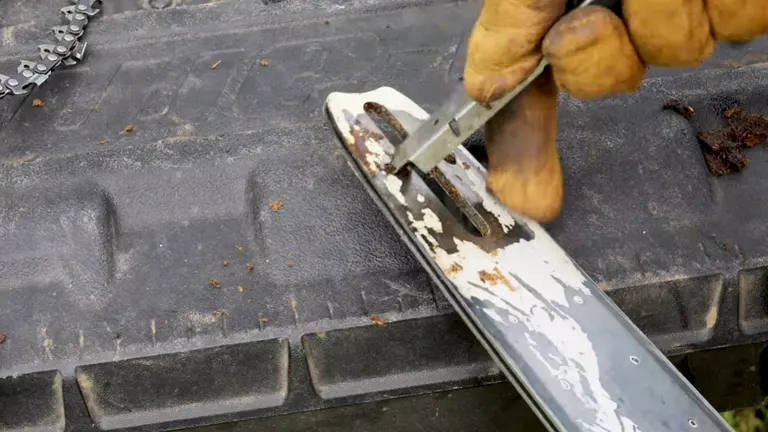
Inspect the sprocket at the bar’s end to ensure it spins freely; a jammed sprocket due to wood debris can halt chain movement. Additionally, clean the mounting hole and check the bar for signs of wear. Regularly inspecting and cleaning these components can significantly impact the chainsaw’s efficiency and safety.
3. Bar Edges Reconditioning
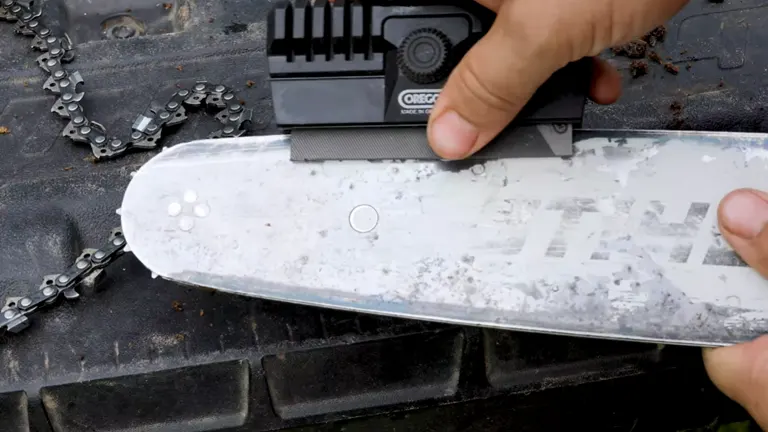
To address the issue of burrs on the chainsaw bar edges, which can hinder the chain’s movement and increase the risk of accidents, reconditioning the edges is crucial. The Oregon 111439 Bar Rail Dresser is an ideal tool for this task, offering a specialized solution that outperforms standard files by precisely smoothing out the bar edges and removing any burrs. Its design is tailored for chainsaw maintenance, ensuring that the chain glides smoothly over the bar, thereby enhancing both the safety and efficiency of your chainsaw operation.
4. Powerhead Cleaning
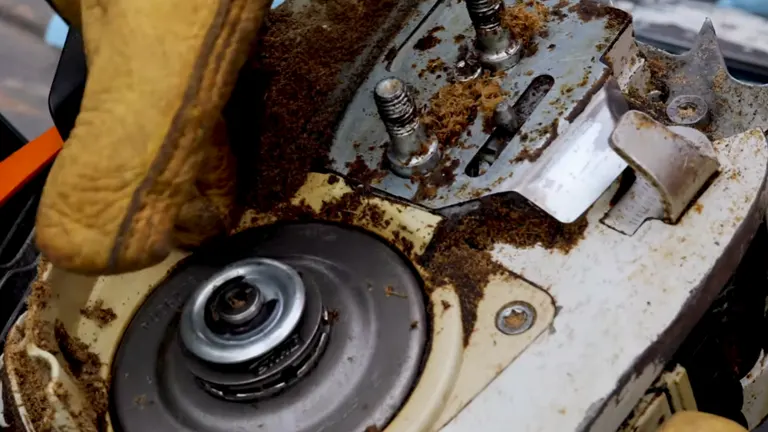
Before reassembling the chainsaw, clean the powerhead thoroughly. This involves removing debris from the chain tensioner screw, the oiler channel, and the sprocket. Regular cleaning prevents build-up that can impair the chainsaw’s functionality and makes future maintenance easier. Additionally, inspect the sprocket for wear and replace it if necessary.
5. Chain Tension and Sharpening
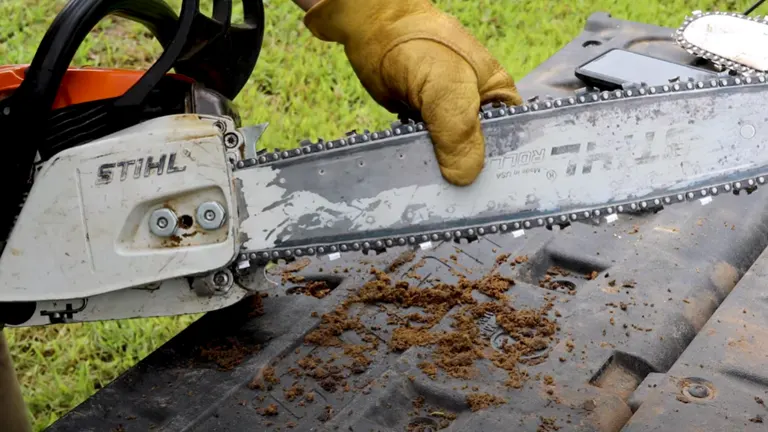
Proper chain tension is crucial for safe and efficient cutting. A chain that’s too tight or too loose can lead to accidents or damage to the chainsaw. Adjust the chain tensioner screw until the chain fits snugly against the bar but can still be moved by hand. Sharpening the chain is equally important; a dull chain requires more effort to cut and can strain the chainsaw. Use a file or a sharpening tool, ensuring you maintain the correct angle and perform an equal number of strokes on each tooth to keep the chain balanced.
Bonus Tip: Winter Storage
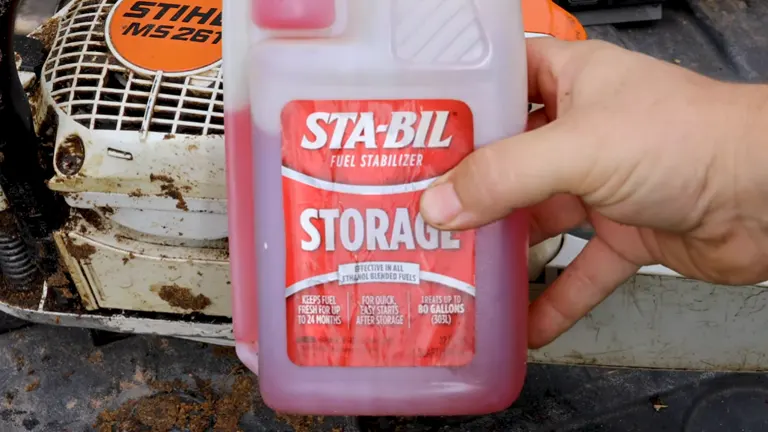
For long-term storage, especially during winter, drain the chainsaw’s fuel or add a stabilizer to prevent the fuel from degrading. This step is crucial to ensure the chainsaw starts easily when next used, preventing carburetor issues caused by stale fuel.
Eco-Friendly Practices for Chainsaw Maintenance
Maintaining your chainsaw doesn’t have to come at the expense of the environment. By adopting eco-friendly practices, you can ensure your maintenance routine minimizes environmental impact. Here are some tips to help you maintain your chainsaw in an environmentally conscious way:
- Opt for biodegradable bar and chain oils that break down more quickly in the environment than traditional petroleum-based oils. These oils provide the lubrication your chainsaw needs while being less harmful to wildlife and plants.
- Instead of throwing away old chains and metal parts, take them to a recycling facility. Many metal components can be recycled, reducing the need for new raw materials and minimizing waste.
- Never pour used oil down drains or onto the ground. Used oil can contaminate soil and water, posing a risk to ecosystems. Collect used oil in a sealed container and take it to a designated disposal or recycling center that accepts hazardous materials.
- Regular maintenance ensures your chainsaw runs more efficiently, which is particularly important for gas-powered models. An efficiently running chainsaw emits fewer pollutants, reducing its environmental impact.
- If you’re in the market for a new chainsaw, consider an electric model. Electric chainsaws produce no direct emissions during use and can be more energy-efficient than their gas-powered counterparts.
- When cleaning your chainsaw, opt for reusable cloths instead of disposable paper towels to reduce waste. These cloths can be washed and used multiple times for various maintenance tasks.
- Encourage fellow chainsaw users to adopt eco-friendly maintenance practices by sharing your knowledge and experiences. Spreading awareness can amplify the positive impact on the environment.
- The market for eco-friendly tools and maintenance products is constantly evolving. Stay informed about new products and practices that can make chainsaw maintenance more sustainable.
Chainsaw Troubleshooting Guide: Common Issues and Fixes
- Difficulty Starting the Chainsaw: Starting problems are often attributed to fuel issues, spark plug problems, or air filter blockage. Ensure your chainsaw is filled with fresh fuel, as old or contaminated fuel can hinder starting. Inspect the spark plug for signs of fouling or damage, cleaning or replacing it as necessary. Additionally, a dirty air filter can restrict airflow, so clean or replace the filter to facilitate easier starts.
- Chainsaw Stalls During Operation: If your chainsaw stalls during use, it may be due to improper carburetor adjustment or fuel line blockages. Adjusting the carburetor to the manufacturer’s specifications can resolve this issue, but if you’re unsure, professional tuning may be necessary. Check the fuel lines for any blockages or leaks, replacing any compromised sections to ensure proper fuel flow.
- Irregular or Rough Cuts: Dull chains, bar wear, and improper chain tension can all lead to unsatisfactory cutting performance. Sharpening the chain can greatly improve cut quality. If the bar is worn or damaged, replacing it is necessary to maintain the correct chain alignment. Additionally, adjust the chain tension to the recommended level; too tight or too loose can affect cutting efficiency.
- Chainsaw Produces Smoke During Use: Smoke production can be a sign of an overheated chain or bar, often due to inadequate lubrication. Make sure the chainsaw’s oil reservoir is full, and check that the oiler is properly dispensing oil. Excessive chain tension can also cause friction and heat, leading to smoke, so ensure the chain is adjusted correctly.
- Excessive Consumption of Bar Oil: An oiler set too high or a leak in the oil system could be the cause. Adjust the oiler to a lower setting to reduce oil flow to a manageable level. Inspect the oil reservoir and delivery system for leaks, sealing or replacing parts as required to prevent oil wastage.
- Excessive Chainsaw Vibration: Excessive vibration might be due to loose components or worn-out anti-vibration mounts. Tighten any loose nuts, bolts, or screws you find. Check the condition of the anti-vibration mounts; if they are deteriorated, replacing them can significantly reduce vibration and improve handling.
- Chainsaw Chain Comes Off the Bar: This issue can arise from a worn sprocket or bar, or from having the chain tensioned incorrectly. Inspect both the drive sprocket and the bar for signs of wear and consider replacements if necessary. Ensure the chain is properly tensioned; a chain that’s too loose can easily slip off the bar during operation.
Conclusion
Maintaining your chainsaw is crucial for ensuring its longevity, performance, and safety. From the meticulous care of the chainsaw bar to addressing common issues through a comprehensive troubleshooting guide, each step in the maintenance process plays a vital role in the overall functionality of your chainsaw. Regular maintenance not only prevents the frustration of unexpected downtime but also enhances the efficiency and safety of your woodcutting tasks. Remember, a well-maintained chainsaw is a reliable partner in your outdoor work, cutting efficiently through challenges and helping you achieve your woodworking goals with precision and ease. Whether you’re a seasoned professional or a beginner, understanding and applying these maintenance tips and troubleshooting solutions will empower you to take better care of your equipment, ensuring it serves you well for many years to come. Embrace these practices, and let your chainsaw’s performance be a testament to the care and attention you invest in its upkeep.
Related Articles:
- Top Reasons Chainsaw Starts, Then Stalls
- What is the Fuel Mixture for a STIHL Chainsaw?
- How To Replace Echo Chainsaw Chain: 15 Easy Steps
- Can a Chainsaw Chain Be Put on Backwards? How to Fix
- How To Switch From Winter Mode To Summer Mode: STIHL Hidden Feature
- How To Get A Chainsaw Unstuck? Expert Tips for a Quick Solution
- How To Use A Chainsaw Depth Gauge
FAQs
- What type of oil should I use for the chainsaw’s bar and chain?
Always use a specialized bar and chain oil for lubrication. These oils are formulated to stick to the chain better, ensuring the chain remains lubricated during cutting tasks. - How frequently should the air filter be cleaned?
Cleaning frequency depends on usage intensity and environmental conditions. For heavy use or dusty environments, clean after each use. Otherwise, inspect and clean every few uses. - Do I need to sharpen the chainsaw chain after every use?
Not necessarily after every use, but regularly check for sharpness. Sharpen the chain when cutting becomes harder or if the chainsaw pulls to one side during cuts. - What are the steps for proper long-term chainsaw storage?
Clean the chainsaw, drain the fuel or add a stabilizer, store it in a cool, dry place, and lightly oil the chain and bar to prevent rust. - How can I tell when it’s time to replace my chainsaw chain?
It’s time for a new chain when it cannot be sharpened to a good edge, shows visible damage, or has stretched beyond adjustment. - Why is it important to rotate the chainsaw bar, and how often should this be done?
Rotating the bar ensures even wear, prolonging its life. Rotate the bar each time you sharpen the chain or perform significant maintenance. - What’s the significance of adjusting chain tension, and how is it properly done?
Proper chain tension is crucial for safe and efficient operation. A chain that’s too tight or too loose can cause damage or accidents. Adjust the tension so the chain snugs against the bar but can still be moved by hand. - Can I use alternative fuels in my chainsaw, like ethanol blends?
It’s best to avoid high-ethanol fuels in chainsaws, as they can damage the engine. Use the fuel type recommended by the manufacturer, typically a specific gas-to-oil ratio. - How do I properly clean the chainsaw’s carburetor, and how often?
Cleaning the carburetor involves disassembly and using carburetor cleaner spray. It’s a delicate task often best left to professionals unless you’re experienced. Do this annually or when performance issues arise. - What maintenance tasks should be performed after each use?
After each use, clean the chainsaw’s body, check the chain tension and sharpness, clean the air filter if necessary, and ensure the oiler is functioning properly. These steps help keep the chainsaw ready for the next job.
Thank you for reading our guide on chainsaw maintenance! We hope these tips help you keep your chainsaw in top shape, ensuring safe and efficient woodcutting experiences. Got more questions, tips, or experiences to share? Don’t hesitate to comment below and join the conversation. Your insights could be a huge help to fellow readers and woodcutting enthusiasts. Happy cutting, and remember to share this article with friends who might find it useful!

David Murray
Forestry AuthorI'm David Murry, a forestry equipment specialist with a focus on chainsaw operation. With over 13 years of experience, I've honed my skills in operating and maintaining a wide range of machinery, from chainsaws to log splitters. My passion for the outdoors and commitment to sustainable forestry drive my work, which emphasizes safety, efficiency, and staying updated with industry advancements. Additionally, I'm dedicated to sharing my expertise and promoting environmental awareness within the forestry community.







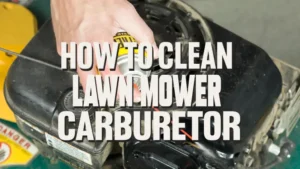





Leave your comment